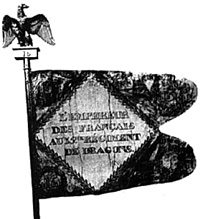
The Lost Eagles
The eagle affixed to the flagpole of each battalion was the most important symbol a French unit possessed, more so even than the unit's actual flag. The loss of an eagle was often tantamount to disgrace, and was the most sought after trophy by French enemies.
However, a problem soon developed with the emphasis light infantry, or legere, units placed on this symbol. Because the legere often fought in skirmish order, it became difficult to provide the same protection for the flag and eagle that formed troops could. On 6 February 1807, one of the 1801 pattern Revolutionary flags of the famed 9th Legere (the Incomparables) was lost in a combat at Mohrungen during the Polish campaign to the 5th Russian Jaegers. One day later, at the horrific battle of Eylau, the 1st Battalion of the 10th Legere lost their eagle and lozenge flag as well. Thus, in a very short time span, two of the very best legere regiments had suffered a disgrace that their conduct did not actually merit. Clearly, the time had come to reconsider the policy of allowing light infantry to carry such prized possessions into the field.
On 27 March 1807, just prior to the commencement of the Friedland campaign, Napoleon decreed that light infantry regiments would send all Eagles back to their depots and keep only their standards in the field.
This article appears in MagWeb (Magazine Web) on the Internet World Wide Web. Light infantry eagles weren't the only ones vulnerable. The first eagle lost by a unit of the Grande Armee occurred at Jungingen--one of the squadrons of the 15th Dragoons allowed this eagle and standard to fall into Austrian hands. Waldenburg Schillingsfurst received a bullet from a French carbine when he snatched this prize; he died three days later at Ulm.
Light infantry eagles weren't the only ones vulnerable. The first eagle lost by a unit of the Grande Armee occurred at Jungingen--one of the squadrons of the 15th Dragoons allowed this eagle and standard to fall into Austrian hands. Waldenburg Schillingsfurst received a bullet from a French carbine when he snatched this prize; he died three days later at Ulm.
Back to Table of Contents -- Napoleon #5
© Copyright 1996 by Emperor's Press.
The full text and graphics from other military history magazines and gaming magazines are available at http://www.magweb.com